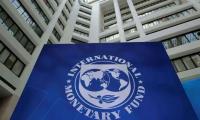By Ahmed Anver
The gallery says about Ahmed Anver in its statement that he qualified from the Central Institute of Arts & Crafts (CIAC) Karachi in 1980 and held a solo show in the Indian city of Jodhpur the same year.
Then in 1983, 1984 and 1985 he held solo exhibitions at the Punjab Council of the Arts Lahore, the Multan Arts Council and the India House Karachi. From 1996 onwards he participated in international exhibitions.
After qualifying from the CIAC Karachi, Anver got a diploma in textile design from Singapore in 1985. Earlier, he had also attended the National Museum of Pakistan Karachi’s artist modeller course from 1977 to 1978 and the Tawakkal screen printing and textile designing course from 1970 to 1982.
His palette makes him distinctive, as he picks a wide range of colours, bright and dark, to fill the geometrical presentations of Kufic inscriptions. No doubt he has a firm grip on colour rendering.
He has acquired mastery over his colours and shapes. Arches, domes and minarets on his canvas remind us of the grandeur of Islamic architecture. The Kufic script keeps us abreast of the Islamic motifs, fascinating the viewers.
Farrah Mahmood
Regarding Farrah Mahmood, the gallery says she is a graduate of the National College of Arts (NCA) Lahore. She specialises in Asian miniature painting, specifically in the style of Mughal miniatures of the subcontinent. She also has an MA in art education from the Beaconhouse National University Lahore.
She has delivered many lectures at different colleges, universities and art institutions at national and international levels, including the UK, the US, Austria, France and China, on a variety of subjects related to visual arts.
Farrah is currently continuing her art practice from her studio and also conducting workshops on traditional miniature painting in the Tumair town of the Islamabad Capital Territory. Her work deals with a range of socio-political issues.
In most of her work, in fact, the attention is drawn to the abuse of power in all its senses, which is the root cause of a corrupt and unjust system, distressing our personal judgment of human values. The emphasis of her work is on peace and humanity.
Her works connect her interests with contemporary experimenting by combining them with traditional miniature painting. She is associate professor in the Department of Architecture & Design at the COMSATS University Islamabad, where she has also established the COMSATS Art Gallery.
Kausar Iqbal
Hailing from a rather conservative area of Malakand in Khyber Pakhtunkhwa, Kausar Iqbal emerges as a very fine artist, says the gallery about the artist.
Discovering his love for art at a very young age, Iqbal acquired his degree in miniature painting from the NCA. He has exhibited his work nationally and internationally. He has also collaborated with several artists.
Being a sensitive and observant artist, he has the ability to create art that represents the cultural mechanism of society. A great deal of the said potential can be seen in his Elephant series, which visualises and highlights certain aspects of human nature.
The elephant’s character renders multiple shades of human behaviour by not only becoming an embodiment of power but also symbolising peace and love. The symbol incorporates the cultural aspect of the artist’s background, representing power as well as simultaneously exhibiting the exuberant humbleness.
Sumaira Amin
The gallery says about Sumaira Amin that she is a traditional miniature painter by temperament and an art educationist professionally. She is a resident of Lahore and graduated in miniature painting from the NCA in 2006. She also completed a one-year diploma in calligraphy from the NCA the following year.
She is well-known for reviving and retaining the Islamic heritage, culture, values and traditions through the art of painting. She is the ambassador of globally protecting conservative means, modes, methods and approaches in the art of painting.
Her excellent artwork was exhibited at the National Museum of Algeria in 2009 and was also displayed at Rome’s National Museum of Oriental Art in 2016. Her work has been featured in the book titled ‘The Lahore Fort Images in Miniature’ that was published by UNESCO in 2006.
She participated in a miniature painting competition in Algeria in 2009 and in an international calligraphy competition in Iran in 2010. She won the third-world miniature painting competition in 2009.
Syed A Irfan
Regarding Syed A Irfan’s work, the gallery says it focuses on traditional Mughal miniature pieces relevant for the Mughal era, connecting the past with the present. His work as an artist is centred on historical iconographic elements within the cultural context of Mughal history.
Irfan has explored and constructs the hermeneutics of period histories and its contemporary representation of socio-political inquiry within his art practice. He interconnects art, design and critical theories and collaborates with the Mughal era, giving his own interpretation in a visual form.
This photograph shows commuters driving on a busy street in Karachi. — AFP/FileFrom the River to the SeaThe Sanat...
The Sindh High Court Hyderabad Registry. — Facebook/Sindh High Court Hyderabad HYDERABAD: The Sindh High Court ...
The screenshot shows a memorandum of understanding being singed between the National Highways and Motorway Police and...
Representational image. — APP FileA local councillor who was wounded during a firing incident in the Quaidabad area...
In this screengrab, Sindh police chief Ghulam Nabi Memon chairs a meeting on March 25, 2024. — Facebook/Sindh...
Mervyn Francis Lobo, chief executive officer of the Marie Adelaide Leprosy Centre can be seen with Dr. Ruth Pfau....







